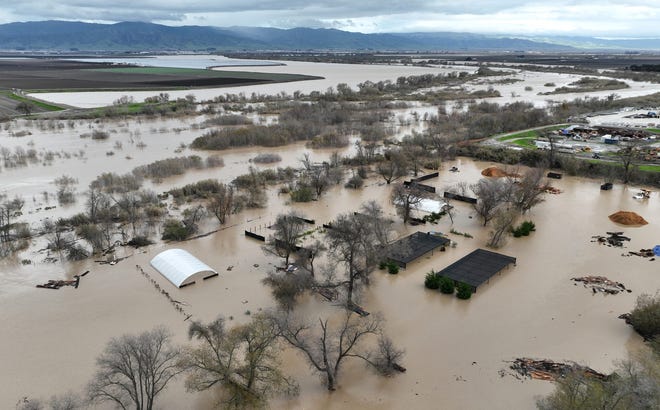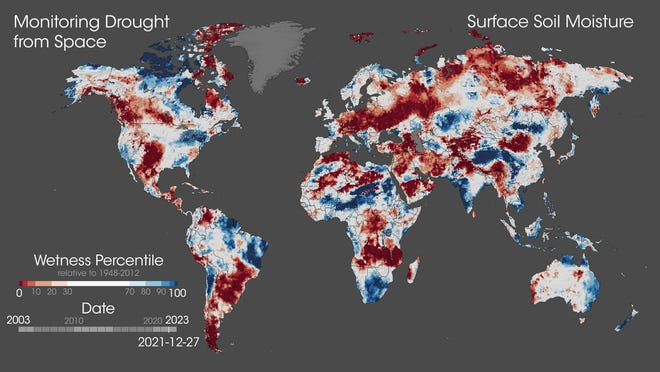Twenty years of NASA’s global satellite data show just how much the extent, duration and severity of extreme droughts and floods have risen alongside warming global temperatures, a new study reveals.
The study looked at the timing of such events and where they’re happening around the world, said study co-author Matthew Rodell, a scientist at NASA’S Goddard Space Flight Center.
Published in the journal Nature Water, the study found a strong correlation between extreme wet and dry events and temperature increases.
More extreme events — more frequent, bigger and more severe — occurred in the later years, since 2015, which have ranked among warmest top 10 on record, Rodell said.
The work adds to a growing body of evidence that suggests continued warming could cause more frequent, widespread and severe droughts and floods.
How does climate change affect you?: Subscribe to the weekly Climate Point newsletter
READ MORE: Latest climate change news from USA TODAY
Weather events are changing
When you have warmer temperatures, you see these more intense events happening, and happening more frequently, Rodell said. It’s “highly likely that as the world continues to warm, we will see more frequent and more severe droughts and (periods of increased rainfall).”
Warmer air causes more evaporation during droughts and increases the amount of water available in thunderstorms and other precipitation during wet events.
A USA TODAY investigation in 2021 showed extreme rainfall has increased in the eastern half of the United States but that droughts were growing more frequent and more intense.
Investigation:How a summer of extreme weather reveals a stunning shift in the way rain falls in America.
Years of study had predicted this could be the case, but like the investigation, most academic studies use rainfall data.
Rodell and Bailing Li, employed by the University of Maryland at the Space Flight Center, used information from NASA satellites. Rodell said the more precise data helps account for underestimates that occur in extreme precipitation data and for uncertainties in rain and snow measurements at higher elevations.

What did the scientists do?
- Observed: Changes in land-based water storage measured by remote-sensing satellites, including groundwater, soil moisture, snow and ice and surface waters around the world.
- Found: 505 wet events and 551 extreme dry events from 2002-2021, with an average duration of 5-6 months.
- Analyzed: Monthly temperature records and monthly total intensity of all wet and dry events and compared them.
What did they find?
One of the key findings: A decrease in frequency of wet events in the U.S. and an increased frequency of dry events, for example the series of droughts in the Southwest since 2012.
Also:
- A “highly correlated’ connection between global mean temperature and the intensity of extreme wet and dry events – combining extent, duration, and severity.
- A stronger connection with temperature than with El Nino or any other circulation patterns.
- A shift from more wet events to more dry events in Southeastern Brazil and within a “vast swath from southern Europe across the Middle East and Arabian Peninsula to south-western China and Bangladesh.”
- More dry events in sub-Saharan Africa and west central South America during the first half of the 20 years, and more wet events in the second half.
- A big flood event that covered most of Central Africa starting in 2019 and still ongoing at the end of 2021 was three times as large as the next biggest wet or dry event in the entire 20-year span.
How rainfall is changing in the US:See how it’s changed your community
Satellite data versus precipitation data
“People kind of intuitively recognize that extreme events are happening more often, but it’s been hard to say with certainty,” Rodell said. “The satellite data gives us a new way of looking at it, that gives us quite a bit of confidence it’s already happening.”
“We’re not always good at measuring extremes in precipitation,” he said. And, measurements of rain and snow can’t account for evaporation and runoff, and don’t see the “big picture” of total amount of water gained or lost.
Rodell and Li used a satellites known as the GRACE satellites, for Gravity Recovery and Climate Experiment. The satellites measure reflected light and monitor each other’s orbits, accounting for gravitational pull that affects any data collected and measuring their orbits “incredibly precisely.”
Similarly to how the US Drought Monitor provides regular monitoring of drought conditions in the nation, “the approach presented by Rodell and Li can provide regular monitoring of extreme wet and dry events globally,” wrote Melissa Rohde, in a piece also published in Nature Water in March.
“Recognizing drought and flood events before they intensify can help water managers respond accordingly to reduce negative impacts,” she said. The Goddard scientists approach “can help communicate the urgency of dealing with climate change.”

Dig Deeper:
USA TODAY
Recent videos of drought around the world:
Dinah Voyles Pulver covers climate and environment issues for USA TODAY. She can be reached at dpulver@gannett.com or at @dinahvp on Twitter.

